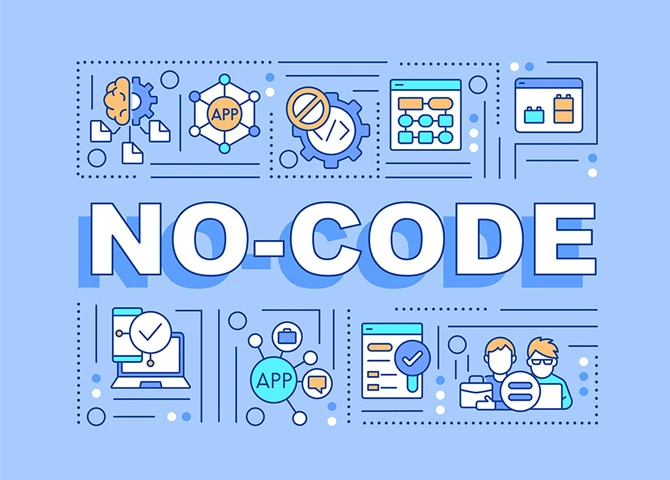In a world where technology touches every part of our lives, building software has become a game-changer for businesses and individuals. But coding can feel like learning a foreign language—intimidating, confusing, and time-consuming. What if I told you there’s a way to create powerful websites, apps, or tools without writing a single line of code?
This is where no-code development comes in. It’s a revolutionary approach that opens up the doors of software creation to anyone, regardless of their technical background.
Whether you’re an entrepreneur looking to build your dream app, a small business owner in need of a custom tool, or a creative professional wanting to showcase your portfolio, no-code platforms make it all possible.
Let’s break down what no-code development is, how it works, and why it’s reshaping the way we think about creating technology.
What Exactly Is No-Code Development?
No-code development is a way to create applications, websites, and tools using visual interfaces instead of traditional coding. Instead of writing complex scripts, you use drag-and-drop elements, templates, and pre-built modules to piece everything together. Think of it like building with LEGO blocks: you pick the pieces you need and snap them into place.
For example, platforms like Bubble App Maker allow you to build sophisticated web apps with minimal effort. You can create user authentication systems, design interactive dashboards, and even manage databases—all without touching code. This simplicity doesn’t mean you’re limited in what you can do. No-code tools are surprisingly powerful, letting you build apps as straightforward as a to-do list or as complex as an online marketplace.
The idea behind no-code development is accessibility. It bridges the gap between technical and non-technical users, empowering you to bring your ideas to life without relying on expensive developers or a technical co-founder.
Why Is No-Code Development Becoming So Popular?
The growing demand for no-code platforms isn’t just hype—it’s a response to real-world challenges. Here are a few reasons why it’s taking off:
- Speed: Building apps or websites with code takes time. No-code tools dramatically cut down development time, enabling you to launch projects in days or weeks instead of months.
- Affordability: Hiring developers or a development agency can be expensive. No-code platforms reduce costs since you’re doing most of the work yourself.
- Accessibility: Not everyone has the time to learn coding. No-code development ensures that even beginners can build functional, professional-grade applications.
- Flexibility: Want to tweak your project? No problem. No-code tools let you make changes on the fly without needing to rewrite code.
- Empowerment: You don’t have to rely on others to bring your vision to life. With no-code, you’re in control of the entire process.
Businesses of all sizes, from startups to established companies, are using no-code platforms to experiment, prototype, and scale their operations faster than ever before.
How Does No-Code Development Work?
No-code platforms are designed to make building apps as intuitive as possible. Here’s how the process generally works:
- Start with a Template or Blank Canvas
Most no-code platforms offer templates for common use cases, like e-commerce stores, booking systems, or portfolio websites. If you prefer starting from scratch, you can work on a blank canvas to fully customize your design. - Drag and Drop Features
Add functionality like buttons, forms, images, or interactive elements by dragging them into place. For example, Carrd is excellent for building one-page websites quickly, with easy-to-use customization tools. - Connect Data
Need your app to store or display information? Most no-code platforms let you create databases or integrate with third-party services like Google Sheets or Airtable. - Set Up Logic
Add workflows and conditions to control how your app behaves. For example, if a user clicks a button, you can set up an action to send an email or display a message. - Publish and Test
Once you’re happy with your app, you can publish it and share it with the world. Many no-code platforms even offer hosting, so you don’t have to worry about technical setup.
Who Can Benefit From No-Code Development?
No-code tools are for everyone, but here are a few groups that especially benefit:
- Entrepreneurs: If you have a business idea but lack technical skills, no-code lets you build your MVP (minimum viable product) quickly and at a lower cost.
- Small Businesses: Custom apps or websites are no longer out of reach for small companies. Automate processes or create unique customer experiences without breaking the bank.
- Freelancers and Creatives: Build portfolios, landing pages, or personal projects with ease. Carrd is a favorite for creating elegant single-page sites.
- Nonprofits: Create donation platforms, community portals, or event management tools to support your mission.
- Enterprise Teams: Even larger organizations use no-code tools to prototype ideas or create internal solutions without waiting on IT departments.
Popular No-Code Platforms to Explore
Here are some standout platforms you can use:
Platform
Best For
Key Features
Bubble
Building complex web apps
Drag-and-drop design, logic workflows, database management
Carrd
Simple one-page websites
Lightweight, affordable, easy-to-use templates
Airtable
Organizing data and workflows
Combines databases with no-code automation
Webflow
Designing custom websites
Offers responsive design tools
Glide
Creating mobile apps
Converts Google Sheets into functional apps
Each platform has its strengths, so your choice depends on what you’re trying to build.
Real-World Examples of No-Code in Action
To show you what’s possible, here are a few real-world examples of no-code development:
- Small Business Automation: A coffee shop uses a no-code app to manage online orders, send automatic confirmations, and track inventory.
- Online Marketplaces: Entrepreneurs have built platforms like Airbnb or Etsy clones with Bubble.
- Portfolio Websites: Creatives showcase their work and attract clients using Carrd or Webflow.
The possibilities are endless, and the only limit is your creativity.
Limitations of No-Code Development
No-code platforms are powerful, but they aren’t perfect for every situation. Here are a few things to keep in mind:
- Scalability: While many no-code apps can handle moderate traffic, high-growth businesses might need to transition to custom-coded solutions.
- Customization Limits: No-code tools offer flexibility, but they might not support highly specific features or integrations.
- Learning Curve: While easier than coding, some platforms still require time to learn.
Understanding these limitations can help you decide whether no-code is right for your project.
Conclusion
No-code development is changing the game, making app creation more accessible, faster, and affordable for everyone. Whether you’re building a small website with Carrd or creating a full-fledged web app with Bubble, no-code platforms give you the tools to turn ideas into reality.
If you’ve been holding back on starting a project because coding seemed like a barrier, now’s the time to dive in. With the right no-code platform, you can create something amazing without ever writing a single line of code.










